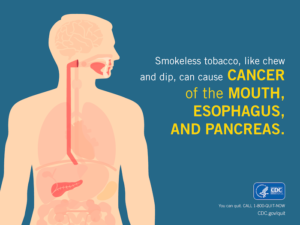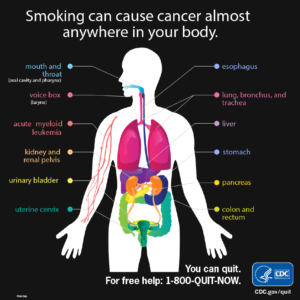There is NO safe way to use tobacco
Tobacco is addictive and dangerous, and the only safe alternative is to quit now.
Tobacco is the leading cause of preventable illness and death in the United States and causes more than 480,000 deaths per year. Secondhand smoke causes approximately 41,000 deaths in the US annually. Tobacco causes cancers, heart disease, and chronic lung diseases, problems with pregnancy as well as other diseases. Nicotine is a substance found in tobacco and tobacco products such as cigarettes, cigars, chew, snuff, dip, hookah, pipe tobacco and most electronic cigarettes. It is very addictive, and companies that manufacture tobacco products add other harmful chemicals to make the nicotine reach the brain much faster, making it more addictive.
Since the first Surgeon General’s report on the dangers of tobacco in 1964 “there have been more than 20 million premature deaths attributable to smoking and exposure to secondhand smoke. Smoking remains the leading preventable cause of premature death in the United States”.
For the most recent Surgeon General’s report on the health consequences of smoking, click here.
Combustible Tobacco Products
Combustible tobacco is any type of tobacco that is lit with a flame and the smoke is inhaled into the lungs, or mouth. This type of tobacco includes cigarettes, cigars, pipe tobacco, hookah and other less common types. In Wyoming, around 800 deaths each year are caused by combustible tobacco use. Tobacco smoke has more than 7,000 chemicals, at least 250 are harmful and at least 70 cause cancer.
|
Smoking can cause cancer almost anywhere in your body:
|
Other health effects of smoking can include:
|
Nicotine, the active ingredient in tobacco, is extremely addictive. Nicotine addiction consists of physical dependence, and psychological craving, which makes nicotine extremely hard to quit. There are resources that can help you quit nicotine, including Wyoming Quit Tobacco. Click the banner at the top or call 1-800-QUIT NOW to start your quit journey with resources proven to increase your chances of quitting for good.
Smokeless Tobacco
Smokeless tobacco is typically a dried, cured loose leaf tobacco which is either chewed or tucked in between the cheek and gum.
 |
Using smokeless tobacco increases risk of:
|
Nicotine, the active ingredient in tobacco, is extremely addictive. Nicotine addiction consists of physical dependence, and psychological craving, which make nicotine extremely hard to quit. There are resources that can help you quit nicotine, including the Wyoming Quit Tobacco Program. Click on the banner at the top or call 1-800-QUIT NOW to start your quit journey with resources proven to increase your chances of quitting for good.
Electronic Nicotine Delivery Systems (ENDS)
ENDS/E-cigarettes (also commonly called “vape” or “JUUL”) have been a rising concern in Wyoming and across the nation. E-cigarettes come in different shapes and sizes. Today, the most common e-cigarette is JUUL, which looks like a flash drive.
ENDS are safer than traditional cigarettes, but they are not safe. They have the potential to benefit adult smokers who completely switch to e-cigarettes but they are never safe for pregnant women, youth, young adults, and adults who are not current smokers. ENDS can contain nicotine and other potentially harmful chemicals.
More research needs to be done to determine the negative health effects to using ENDS products over a long period of time and if they can help adult smokers to quit.
ENDS devices can be used to deliver THC products. THC containing ENDS products are associated with the recent lung injury outbreak. For up to date information on this topic, please visit the link below. https://www.cdc.gov/tobacco/basic_information/e-cigarettes/severe-lung-disease.html.
For more information on THC products please visit the following link: https://www.cdc.gov/marijuana/health-effects/index.html
One JUUL pod contains the same amount of nicotine as a pack of cigarettes.
A Centers for Disease Control and Prevention study found 99% of e-cigarettes products tested contained nicotine. Using nicotine has known health effects including:
- Nicotine addiction
- Toxicity to developing fetuses
- Harming youth brain development
- Increased risk for other addictions
Other potential negative effects of using ENDS products include:
- Nicotine poisoning from swallowing, breathing, or absorbing too much e-cigarette liquid
- Injury from explosions or fires caused by defective e-cigarette batteries
- Unknown health effects of inhaling the chemicals in ENDS aerosol including flavors, heavy metals, cancer causing chemicals, and ultra fine chemicals
Nicotine use by youth is particularly concerning because it can harm the parts of the brain that control attention, learning, mood, and impulse control. Each time a new memory is created or a new skill is learned, stronger connections – or synapses – are built between brain cells. Young people’s brains build synapses faster than adult brains. Nicotine changes the way these synapses are formed.
If you are an adult looking for help quitting an ENDS product please click the banner at the top or contact 1-800-QUIT NOW for free resources that can help.
Parent/Guardian/Teacher Resources:
- Talk with Your Teen About E-Cigarettes – a tip sheet (Centers for Disease Control and Prevention)
- How to Help your Teen Quit E-cigarettes (Truth Initiative)
- Know the Risks (U.S. Department of Health and Human Services)
- Become an EX Program for parents/guardians of teen e-cigarette users (Truth Initiative)
Youth Resources:
- thetruth.com (Truth Initiative)
- 5 tips for handling nicotine withdrawal (The Truth Initiative)
- This is Quitting – program to help youth quit e-cigarettes (The Truth Initiative)
- My Life My Quit – free, confidential program that can help youth between 12-17 quitsmoking and vaping (Wyoming Quit Program)
Free Curriculum
- The Real Cost of Vaping (U.S. Food & Drug Administration & Scholastic)
- Tobacco Prevention Toolkit (Stanford Medicine)
- Know the Risks (Centers for Disease Control and Prevention)
Heated Tobacco Products
Heated tobacco products (HTPs) like IQOS and Eclipse, sometimes marketed as “heat-not-burn” technology, represent a diverse class of products that heat the tobacco leaf to produce an inhaled aerosol. They are different from e-cigarettes, which heat a liquid that can contain nicotine derived from tobacco (CDC).
HTPs are available in at least 40 countries and have several have been authorized for sale in the United States by the FDA. In 2018, few U.S. adults (2.4% of all surveyed, including 6.7% of current smokers surveyed) had ever used HTPs. Youth use of HTPs is unknown, but monitoring is underway (CDC).
Scientists are still learning about the short-term and long-term health effects of HTPs, but the available science shows they contain harmful and potentially harmful ingredients. Youth use of any tobacco products, including heated products, is unsafe (CDC).
Secondhand Smoke
Secondhand smoke exposure contributes to about 41,000 deaths of non-smoking adults non and 400 infant deaths each year (CDC). There is no safe level of secondhand smoke exposure.
Secondhand smoke can cause:
- Stroke
- Lung cancer
- Coronary heart disease
Smoking in another room or opening a window does not protect children from secondhand smoke. Cigarette smoke can travel under doors, windows, and through cracks. It can also get inside from stairwells and hallways. Smoke from one cigarette can linger in a room for an hour. Because of this, smoke can be harmful to children in the room even if no one is currently smoking. It is important to avoid smoking at home, in the car, and in public places with children in order to protect youth from the health effects of secondhand smoke.
Children who are exposed to secondhand smoke are at increased risk for:
- sudden infant death syndrome
- acute respiratory infections
- middle ear disease
- more severe asthma
- respiratory symptoms
- slowed lung growth.



